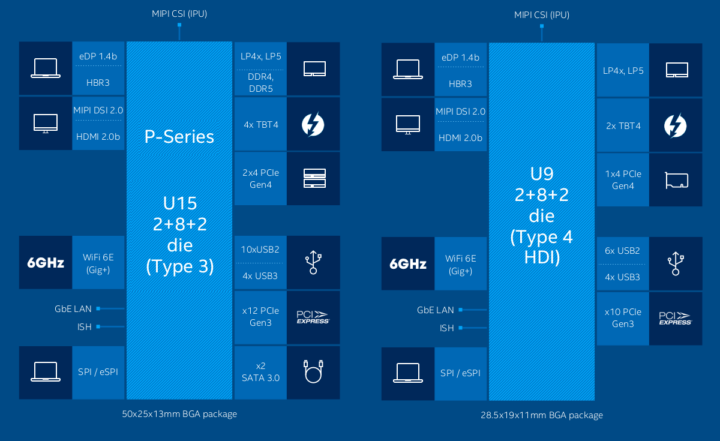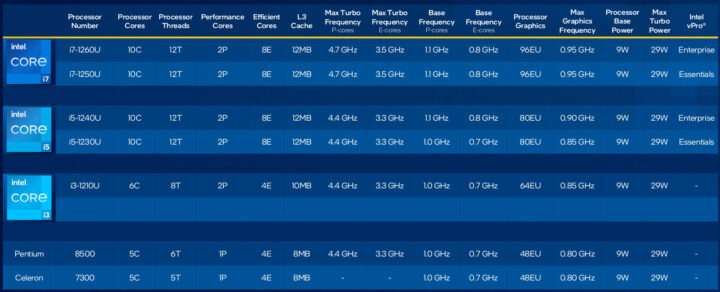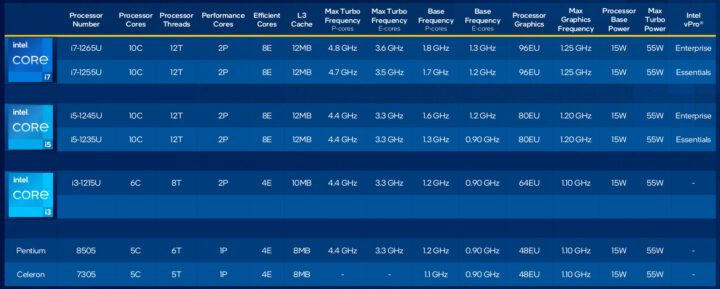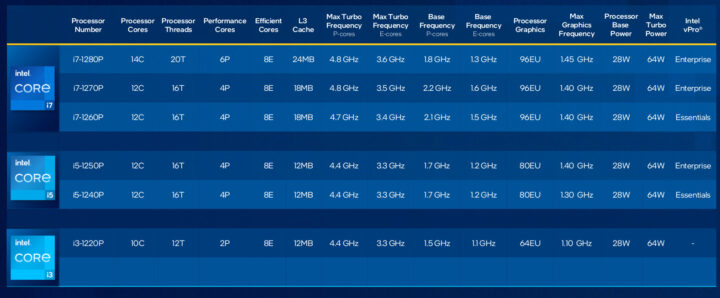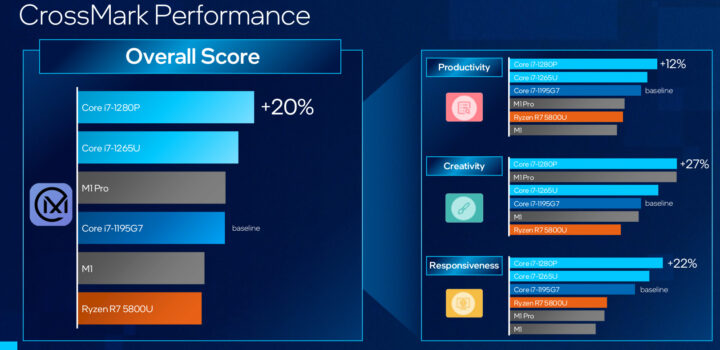Intel first unveiled the most powerful Alder Lake H-Series last year before the launch in January, and also introduced Alder Lake-S desktop IoT processors and Alder Lake U-Series and P-Series mobile IoT SoCs in early January.
But now the company has announced the launch of the Alder Lake P-Series (28W) and U-Series (9W and 15 PBP) 12th generation mobile processors designed for “thin-and-light” laptops which should become available around March 2022.
The block diagram of the 28W P-Series and 15W U-Series (source: product brief from Intel) shows both offer the same interfaces including eDP 1.4b, HDMI 2.0b, 2x PCIe Gen4, 12x PCIe Gen3, 2x SATA… and the same 50x25x12mm BGA package. But the 9W U-Series comes in a cost-optimized 28.5x19x11mm BGA package that does without SATA interfaces, a lower number of PCIe Gen3 interfaces (10 vs 12), USB 2.0 interfaces (6 vs 10), Thunderbolt 4 interfaces (2 vs 4), and only one PCIe Gen 4 interface.
Intel Alder Lake U-Series (9W) SKUs
All the new processors launched today are hybrid models with both Performance (P) and Efficiency (E) cores. The 9W family starts with 1P+4E configuration with the Celeron 7300 and Pentium 8500, up to 2P+8E configuration in the Core i7-1260U, i7-1250U, i5-1240U, and i5-1230U. The remaining Core i3-1210U comes with two Performance cores and four Efficiency cores. While the Max Turbo Power (MTP) for those parts is 29W.
Intel Alder Lake U-Series (15W) SKUs
The 15W SKUs are basically the same but with higher based and max turbo frequencies for both the Performance and Efficiency cores. The nomenclature is similar with Pentium 8500 (9W) becoming Pentium 8505 (15W), and i7-1260U becoming i7-1265U. The Max Turbo Power goes up to 55W. The 15W should offer higher performance, but the biggest difference against the 9W part could be the selection of interfaces.
Intel Alder Lake P-Series (28W) SKUs
The P-Series up the performance quite a bit with the entry-level Core i3-1220P starting at 10 cores with two Performance cores, and eight Efficiency cores. The top-end processor of the family, the Core i7-1280P, comes with 14 cores (6P @ 1.8 GHz/4.8GHz and 8E @ 1.3 GHz/3.6GHz), 24MB L3 cache, and a 96EU Intel Xe GPU clocked at up to 1.45 GHz. The MTP goes up to 64W.
Intel provides some performance metrics and comparisons in the slides for the media and analyst presentation with claims up to 70% improved multi-threaded performance for the P-Series (Core i7-1280P), 17% faster web browsing, and 30% faster photo editing when compared to the Intel Core i7-1195G7 Tiger Lake processor. CrossMark benchmark shows a 20% improvement.
Intel added processors from Apple and AMD to the chart above for good measure, but note that they should be more efficient. For instance, AMD Ryzen 7 5800U has a default TDP of 15W (configurable between 10 and 25W). Other highlights include Intel Wi-Fi 6E (Gig+), Thunderbolt 4, and the Imaging Processing Unit 6 (IPU 6.0) to deliver higher quality photos/video conferencing. Intel also notes the new processors support up to four 4K displays, a 12-bit video pipeline, as well as up to 8K30 10-bit HEVC/VP9 encode.
More details may be found in the announcement. We may have more Alder Lake announcements, as Intel did not talk about the expected Alder Lake-M/M5 family with a 5/7W BPB designed for tablets.

Jean-Luc started CNX Software in 2010 as a part-time endeavor, before quitting his job as a software engineering manager, and starting to write daily news, and reviews full time later in 2011.
Support CNX Software! Donate via cryptocurrencies, become a Patron on Patreon, or purchase goods on Amazon or Aliexpress


